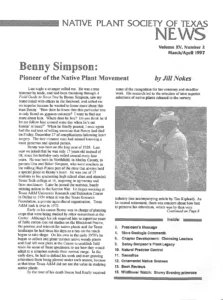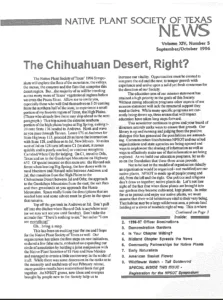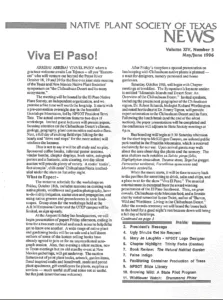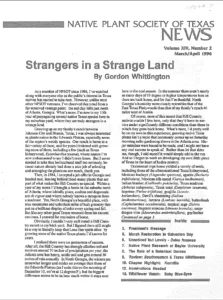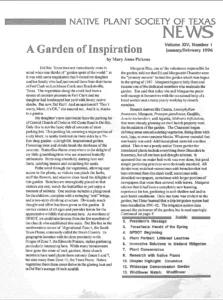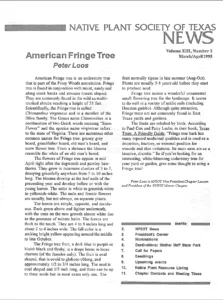Latest Issues

Fall 2025 Member Magazine
President’s Message | Executive Update | Celebrating Leadership | Curb Appeal with a Cause | Grant Recipients | Autumn’s Perfect Pairing | Native Plant Database | Sustainable Landscaping | Winterizing Tips

Summer 2025 Member Magazine
Executive Summary | Resilience in Bloom | Suburban Sanctuary | Texas-tough Summer Survivors | Where Salsa Meets Sage | A Rain Garden Grows | Member News | Smart Watering

Spring 2025 Member Magazine
Executive Summary | Blooming with Possibility | Wildflower Waltz | Native Grasses | Member News | Texas Wildflower Day
Distribution
- Texas Native Plants is published quarterly and the digital version is distributed free to all Society members in current standing.
- The digital version is also available in our library below.
- Print versions are mailed at no cost to Society members in current standing who select to receive a print copy when they join/renew.
- Libraries, educational institutions and other organizations may qualify to receive the publication for a $5 annual fee.
- Contact the membership coordinator.
- Many of our chapters publish their own newsletters and websites.
- These have their own deadlines and guidelines. See list of chapters.
History
Since its founding the Society has provided a news periodical to its members. there have been a variety of names and formats. The Texas Wildfower Newsletter edited by Carroll Abbott served as the first newsletter. He advocated the formation of the Native Plant Society of Texas in his quarterly publication Texas Wildflower Newsletter. After the Society was created in 1980, a free subscription to Abbott’s newsletter was provided as a benefit to all members. His declining health eventually prompted Abbott to request that the Society start its own newsletter. Lean more about the Carroll Abbott story.
Beginning in 1983 our own official publication has documented the evolution of the native plant movement and the Native Plant Society of Texas. The publication has had several slightly different names and formats over the years. By 2005 it had evolved into a full-color glossy magazine.
Editorial Submissions
The Native Plant Society of Texas encourages submission of articles, photos, pertinent news or other interesting information for publication.
- Submit articles or written items as email attachments.
- Send photos as email attachments in JPG, RAW or TIFF format.
- Larger file size and best quality are preferable.
- Contact the Editor for more information.
We reserve the right to edit all submissions for accuracy, relevance, length, grammar or for other reason. In matters of style our print publication generally follows the Chicago Manual of Style.
Unless prior arrangements with the editor are made, submissions may also appear on our website and linked on our social media pages. We do not accept outside advertising in any of our publications.
Publications Library
Click below to view issues by year/editor. Or visit our online archive.
1998 – May/June
- Teaching Tools for Local Chapters
- Landscaping & Color Theory
- Native Plants In Your Landscape
- Evaluation of Native TX Wildflowers
- The Llano Landscape
- Opuntia leptocaulis, Rhamnus caroliniana, Baptisia sphaerocarpa
1998 – Mar/Apr
- Development Sprawl
- Atriplex canescens, Verbesina virginica, Chilopsis linearis
- Native Plants for State Buildings
- Native Flowering Trees
- Research at Texas Tech U.
- Coreopsis tinctoria
1998 – Jan/Feb
- Living On a Gold Mine…
- Mulch w/ Leaves
- Landscaping w/ Natives
- Prosopis glandulosa, Nothoscordum bivalve
1997 – Nov/Dec
- Profile: Carroll Abbott
- Living On Earth
- Flora of Texas Project
1997 – Sep/Oct
- Lynn Lowrey Memorial
- What’s In a Successful Nursery?
- How Do You Measure Success?
- Euphorbia bicolor
1997 – Jul/Aug
- Yucca torreyi, Ipomoea trichocarpa
- Landscaping w/ Natives
- Water-wise Landscaping
- Group Activities: Spread the Word
- Ecological Restoration
- Greenbelts Along TX Highways?
1997 – May/June
- Brush Up on the Brush Country
- Texas In Bloom!
- Environmental Partnering
- The Hunt for Chisos Red Oak
- Lycium berlandieri, Ipomopsis rubra
1997 – Mar/Apr
- Benny Simpson Memorial
- More Geologic Comments
- Natural Predator Control
- Sassafras albidum, Oenothera speciosa
- Ornamental Native Grasses
1997 – Jan/Feb
- Legumes of Rio Grande Plains
- Kidscapes at Houston Zoo
- Smilax smallii, Taraxacum officinale
- Ornamental Native Grasses
- How Plant Distribution Relates to Geology
- Conservation: Hibiscus dasycalyx
1996 – Nov/Dec
- Early Naturalists – Part II
- Creating Your Own Wildlife Habitat
- Thelesperma megapotamicum
- Focus: SFA Arboretum
- Spiranthes cernua
1996 – Sep/Oct
- The Chihuahuan Desert, Right?
- Demo Gardens on Property Controlled by Others
- Is Your Chapter Wilting?
- Community Partnerships for Native Plants
- Early Naturalists
- Centaurea americana
- Solidago canadensis var. scabra
1996 – July/Aug
- Native Plants of El Paso
- John Riddell, Naturalist
- Gilia rigidula
- Outdoor Classrooms
- Focus: Center for Plant Conservation
- A Desert Oasis
- Eustoma grandiflorum
1996 – May/June
- Viva El Paso!
- Ugly Shrubs Get No Respect
- Mary Jo Laughlin Memorial
- Amorpha fruticosa
- Container Production of Native Trees for Urban/Suburban Landscapes
- Growing Wild: State Pilot Program
- Phlox drummondii
1996 – Mar/Apr
- Strangers In a Strange Land
- Marsh Restoration In Galveston Bay
- Dalea formosa
- Native Plant Research at Baylor U.
- Role of Botanical Garden in Plant Conservation
- Callirhoe scabriuscula
1996 – Jan/Feb
- A Garden of Inspiration
- Forsellia: Herald of the Spring
- Beginnings of the Society
- Leucaena retusa
- Solutions to Wetland Mitigation/Preservation
- Native Plant Research at Universities
- Wildscape Demo Garden
1995 – Nov/Dec
- Native Plants for Suburbia
- Seedlings: A Tall Grass Meadow
1995 – Sep/Oct
- Waco – City w/ a Soul
- The Lynn Lowry Legacy
- Helianthus maximiliani, Manihot walkerae
1995 – Jul/Aug
- Growing Natives: New Plants, New Problems
- Imported Fire Ant Control
- NPSOT, City of Austin Median Beautification
1995 – May/June
- TxDOT Mowing Guidlelines
- The Buttonbush
1995 – Mar/Apr
- American Fringe Tree
- Mother Neff State Park
- Native Plums









